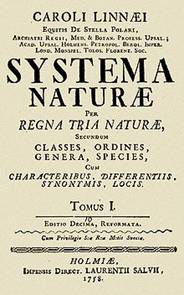Carl Linnaeus (1707-1778)
Born in 1707 in Råshult, Sweden, Carl Linnaeus was a botanist, physician and zoologist. He is known as the father of modern taxonomy, and is also considered one of the fathers of modern ecology. At the age of five Carl had his own garden, which he later said, "inflamed my soul with an unquenchable love of plants." His scientific studies of plants began when he was in medical school. All medical students of that time studied the medicinal and dietary uses of plants, but Carl Linnaeus felt the classification system used at the time was inadequate and difficult to use.

Linnaeus became Professor of Botany at Uppsala University in 1741. He taught botany, zoology and other subjects, and he was very popular with his students. In the 1740s, he went on several journeys through Sweden to find and classify plants and animals. In the 1750s and 1760s, he continued to collect and classify animals, plants, and minerals. He was appointed chief royal physician in 1747 and was knighted in 1758, when he took the name Carl von Linné. At the time of his death, he was one of the most renowned scientists in Europe, and has been called the Prince of Botanists. Linnaeus created a formal classification system for all living things, using genus and species to create binomial names. When he presented this classification system to his contemporaries, he received input from various botanists, who, like himself, believed it was important to construct a comprehensive structure for recording plant type and use. Linnaeus's classification system grew and grew, and soon his contemporaries were sending him specimens for him to name, record and classify. He spent his life searching for new plant species, documenting specimens and experimenting with crop production.
The first edition of Systema Naturae was printed in the Netherlands in 1735. It was a mere twelve-page work. By the time it reached its 10th edition (1758), it classified 4,400 species of animals and 7,700 species of plants. He published Philosophia Botanica in 1751. The book contained a complete overview of the taxonomic system Linnaeus had been using in his earlier works. It also contained information on how to keep a travel journal and how to maintain a botanical garden.http://en.wikipedia.org/wiki/Carl_Linnaeus - cite_note-Blunt221-87 In 1753 Linnaeus published Species Plantarum, the work which—together with his earlier Systema Naturae—is internationally accepted as the beginning of modern botanical nomenclature. The book contained 1,200 pages and was published in two volumes; it described over 7,300 species.


References and featured material
- Carl Linnaeus (wikipedia.org)
- Carl Linnaeus (notablebiographies.com)
- Botanical hunter-gatherers (telegraph.co.uk)
Top of Page